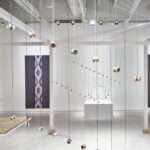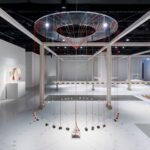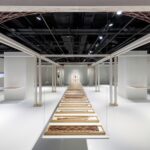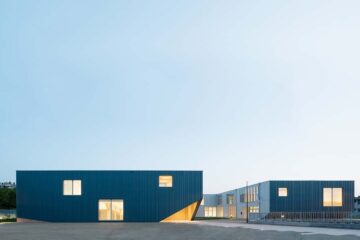Weaving Tradition: KUMIHIMO Exhibition Space by DOMYO

London, England, UK, 21 February 2023 - Kumihimo exhibition at Japan House London
The exhibition space for ‘Yushoku Kumihimo Domyo’ at the Japan House in London, São Paulo, and Los Angeles, designed by Rei Mitsui Architects, epitomizes the fusion of tradition and modernity. Crafted with meticulous attention to detail, the space provides a serene backdrop for showcasing the intricate beauty of kumihimo silk braiding.

Conceptualization and Design Philosophy
The challenge of showcasing delicate kumihimo within a vast gallery space prompted the architects to conceive a design that would accentuate the intricacies of the craft. Rather than opting for a stark, sterile environment, they envisioned a space reminiscent of flowing water—transparent yet brimming with vitality. Inspired by the concept of himorogi—a sacred boundary in Shinto tradition—the design creates distinct zones where kumihimo takes center stage, free from distractions.
Spatial Structure and Detailing
Central to the design is a grid of nine frames, arranged in a mandala-like configuration symbolizing the cyclical nature of time. Each frame, though appearing minimalist at first glance, is meticulously crafted to incorporate intricate detailing. Constructed from cedar wood and coated with gofun—a traditional mixture of powdered seashells—the frames exude a subtle translucency, allowing the underlying texture of the wood to subtly emerge.

Earthy Elements and Symbolism
To ground the delicate frames, ceramic plinths reminiscent of ancient pillar construction were introduced. These earthy elements not only provide structural support but also establish a tactile connection between the industrial gallery space and the delicate kumihimo frames. Drawing parallels with the ancient method of hottate-bashira—’dig and erect’—the use of earthen blocks reinforces the deep-rooted history and craftsmanship associated with kumihimo.
Historical Context and Materiality
In weaving together historical context and materiality, the architects pay homage to the enduring legacy of kumihimo. By evoking traditional construction techniques and utilizing natural materials, the exhibition space becomes more than a mere backdrop—it becomes a sacred vessel that honors the craftsmanship and cultural significance of kumihimo through the ages.






























